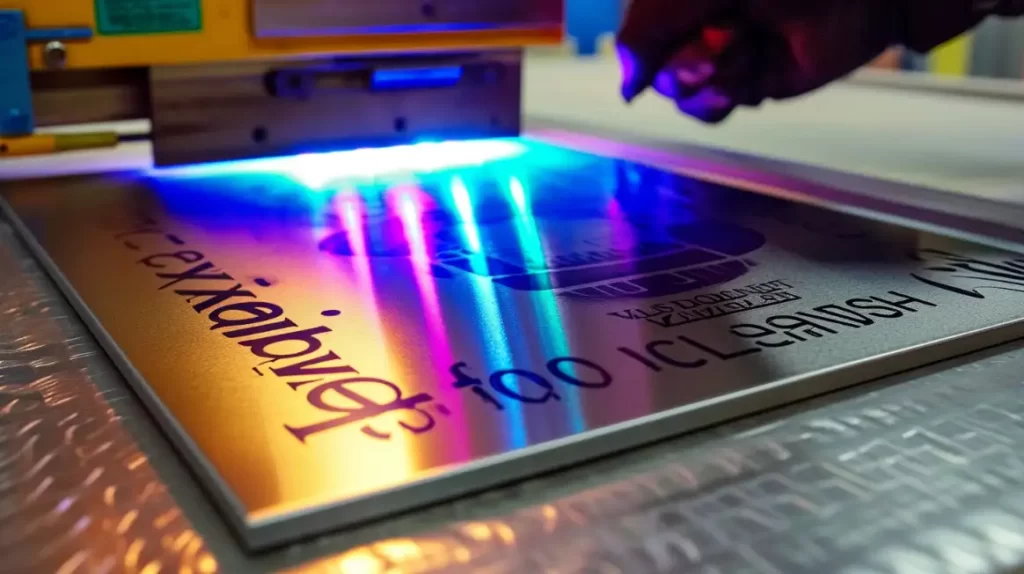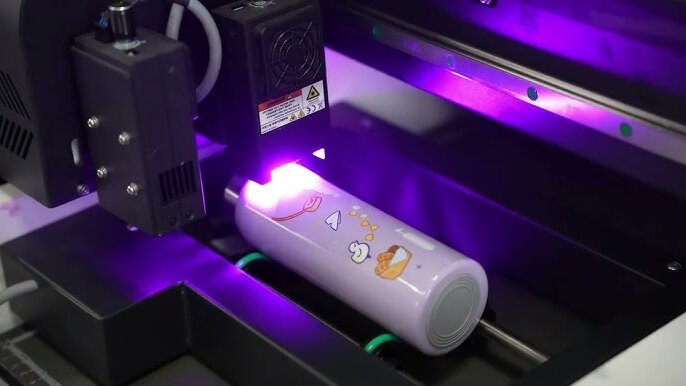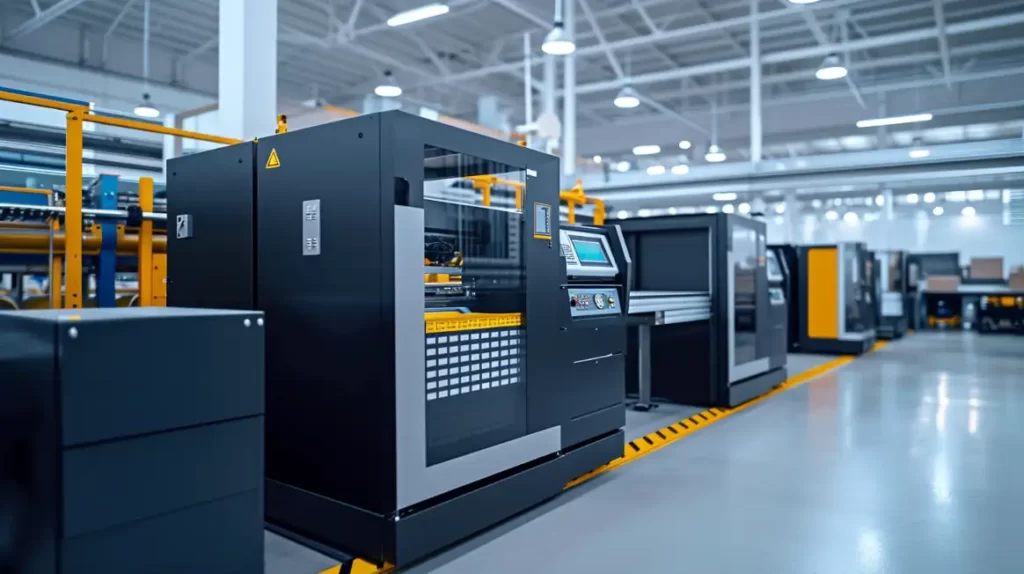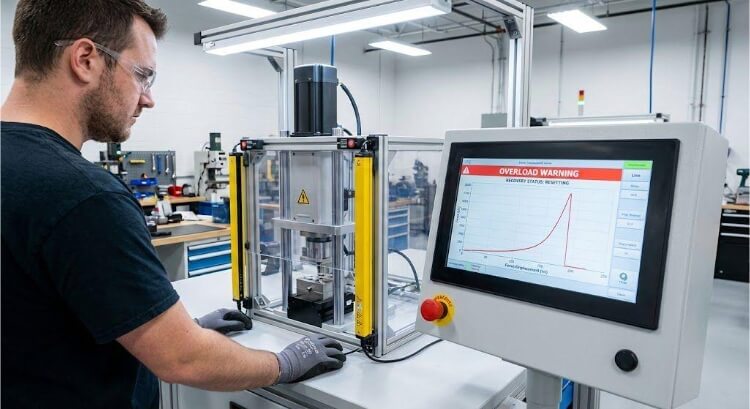Many manufacturers still rely on stickers or paint to add graphics or text to metal parts. But those methods often peel, fade, or wear off. UV printing offers a fast, durable solution. This method uses ultraviolet light to cure ink instantly, creating vibrant, scratch-resistant prints. For teams seeking fast, reliable labeling or design on metal parts, this method solves many common problems.
This process changes how teams label, brand, or decorate metal surfaces. Let’s walk through how it works and why so many industries use it.
What Is UV Printing on Metal?
UV printing on metal is a digital printing method that uses ultraviolet light to cure specially formulated ink. The printer sprays the ink directly onto the surface. Then, UV lamps follow immediately to harden the ink. This fast curing process keeps the ink from spreading or soaking into the material.
The ink dries instantly. That means no smudging or waiting. It sticks well to many surfaces like plastic, glass, wood, and especially metal. Because there’s no heat involved, the process works well, even on thin or coated metal sheets.
UV printing supports high-resolution images. It creates smooth gradients, crisp text, and complex graphics. It’s ideal for projects that need both durability and sharp detail.
The Science Behind UV Printing on Metal
UV printing may look simple on the outside, but there’s some smart chemistry behind it. This section explains how the ink sticks to metal and how UV light locks everything in place.
How UV Ink Bonds with Metal Surfaces?
UV inks are made with acrylic-based monomers and photo-initiators. When the ink lands on the metal surface, it stays in liquid form for a split second. Then, as UV light hits it, the photo-initiators trigger a reaction. This reaction makes the ink harden almost instantly.
Metal doesn’t absorb ink the way paper does. So, for good results, surface prep is key. The surface might be cleaned or coated to improve ink grip. Some printers also use a primer to help the ink stick better to smooth or polished metal.
Once cured, the ink forms a tight bond with the surface. It doesn’t peel, chip, or fade easily. This is why UV printing works well for labels, branding, and markings that need to last.
The Role of UV Light in the Curing Process
UV light is what makes this whole process possible. It hits the ink right after printing and starts a photochemical reaction. This reaction turns the liquid ink into a solid film in less than a second.
Because the ink cures instantly, it doesn’t have time to spread or run. This leads to sharper lines and better image quality. It also means you can handle or pack the part right away—no drying racks, no downtime.
UV light also helps the ink resist heat, water, and chemicals. This makes the final print strong enough for outdoor use or strict industrial settings.

Step-by-step Metal UV-Printing Process
UV printing on metal follows a straightforward, repeatable workflow. Here’s the step-by-step process:
Step 1: Surface Preparation
Metal surfaces often have dust, oil, or oxidation. These can stop the ink from sticking well. So, the first step is to clean the surface. This may involve wiping with alcohol or using a plasma or flame treatment.
For smooth or coated metals, a primer might be added. This helps the ink stick better and keeps the print from peeling later.
Step 2: Design Setup
Next, the design is prepared using digital printing software. The image or text is sized to fit the part. The colors, resolution, and layout are checked to match the final product.
Once ready, the design is sent to the UV printer. No screens or plates are needed, which saves time.
Step 3: Material Placement
The metal part is then placed in the printer. Flatbed UV printers can hold many shapes and sizes, from flat sheets to assembled parts. Positioning is key to making sure the print lands in the right place.
Some machines use a jig or fixture to hold the item still during printing.
Step 4: Printing and Immediate UV Curing
The printer head moves over the metal and sprays the ink. Right behind it, UV lights follow to cure the ink instantly.
Each color is applied and cured in layers. This keeps the print sharp and avoids smearing. Once done, the part is ready for use—no extra drying or baking is needed.

Types of Metals Suitable for UV Printing
UV printing works on many types of metal. The key is surface preparation and using the right primer when needed. Here are the most common metals used.
Aluminum
Aluminum is one of the easiest metals for UV printing. It’s lightweight, rust-resistant, and has a smooth surface. It’s often used for signs, LED panels, nameplates, and enclosures.
Stainless Steel
Stainless steel is strong and corrosion-resistant. It’s used in tools, machinery covers, and control panels. UV printing gives it a clean, permanent label or design. Because the surface is hard and smooth, stainless steel may also need a primer before printing.
Brass and Copper
Brass and copper offer a more decorative or classic look. They’re used in tags, plaques, and hardware parts. UV printing works well, but the ink may react over time with uncoated surfaces. A clear topcoat can protect the print.
Coated and Anodized Metals
Some metal parts have powder coatings or anodized layers. These finishes make the surface more complex or more colorful. UV printing can go directly on top, but adhesion depends on the coating type.
Benefits of UV Printing on Metal
UV printing offers more than just good looks. It’s a wise choice for manufacturers who want speed, strength, and flexibility—all in one process.
High Durability and Scratch Resistance
Once cured, UV ink forms a solid layer that sticks tightly to the metal. It resists scratches, moisture, and chemicals. This makes it ideal for products used in rough or outdoor environments.
Fast Turnaround Times
UV printing skips many steps used in older methods. There’s no screen-making, long drying time, or complex setup. You load the file, print it, and it’s done.
Eco-Friendly and Low VOC Emissions
UV inks cure without heat or solvents. That means they release fewer harmful fumes, or VOCs, into the air. There’s less waste, too—no extra chemicals or wash-up liquids.
No Need for Plates or Screens
Traditional printing needs screens, molds, or plates. UV printing doesn’t. It’s fully digital. You can switch designs quickly and run small batches without extra costs.

Applications of UV Printed Metal
UV printing fits well in industries that need strong, clear, and long-lasting prints on metal. It’s now used for both practical and decorative parts.
Industrial Signage and Control Panels
Factories and equipment often need clear signs, warnings, and control panel labels. UV printing produces readable text and symbols that resist wear, chemicals, and moisture. These signs stay sharp in heavy-use environments.
Promotional and Custom Metal Gifts
UV printing allows full-color graphics on metal gift items. Think of custom bottle openers, plaques, phone stands, and keychains. The process supports short runs with variable designs. This is perfect for giveaways, branding, or limited editions.
Branding Plates and Nameplates
Many companies use metal nameplates to display logos, product info, or serial numbers. UV printing makes these plates look clean and professional. It works on small batches and high volumes, with options for color and detail.
Electronic Device Labels and Markings
Devices like chargers, routers, and panels need small, precise markings. UV printing provides sharp text and symbols on metal housings. These prints resist rubbing, heat, and outdoor use, making them reliable for consumer and industrial electronics.
Equipment and Technology Used
UV printing on metal depends on reliable machines, quality ink, and the right digital tools. Here’s a closer look at what’s involved.
Flatbed UV Printers
Flatbed printers are the most common machines for printing on metal. They have a flat surface where parts are placed during printing.
These printers move the print head across the item while UV lights follow. They support different part sizes, including small tags or large panels. Some models also handle slightly curved parts.
Ink Types and Cartridge Systems
UV printers use special inks made to cure under UV light. These inks come in sealed cartridges or refillable tanks. Most printers support CMYK color, and some add white or clear ink for special effects.
The ink must match the metal type and the surface condition. Good ink adhesion is key to lasting results.
Software and Design File Requirements
Printing starts with the right design. Software like Adobe Illustrator or CorelDRAW is often used to prepare artwork. The file is then exported in a compatible format—usually PDF, AI, or EPS.
The printer software adjusts the layout, resolution, and color profile. You can set print area, pass count, and curing strength. This helps control ink use and print quality.
Compare Screen Printing and UV Printing of Metal
Both screen printing and UV printing are used to mark or decorate metal. But they work in very different ways and serve different needs.
Process Differences
Screen printing pushes ink through a mesh stencil onto the metal surface. Each color needs its screen. It takes time to set up and is better for large batches. UV printing uses digital files. It sprays ink directly and cures it with UV light. No screens or setups are needed.
Speed and Flexibility
Screen printing is slower to start but fast once running. It’s excellent for repeating one design many times. UV printing is quick to begin and perfect for small runs, changes, or one-off jobs.
Detail and Resolution
UV printing offers sharper images and fine details. It works well for small text, logos, or photo-quality graphics. Screen printing can’t reach the same level of sharpness, especially on tiny parts.
Durability
Both methods can produce strong results. But UV ink cures into a hard layer that resists scratches, chemicals, and fading without extra steps. Screen-printed parts may need extra coatings to match that level of durability.
Cost and Waste
Screen printing requires more materials—screens, setup time, and cleanup. This adds cost and waste. UV printing uses less ink and has fewer steps. It’s more efficient for short or mixed jobs.
Conclusion
UV printing on metal is a fast, precise, and durable way to add graphics, text, and labels to metal surfaces. It works on aluminum, stainless steel, copper, and more. The process doesn’t need screens or long drying times. From industrial panels to branded nameplates, UV printing offers reliable results across many industries.
Need custom UV-printed metal parts? We support fast quotes, short lead times, and full technical support. Contact us today to start your next project.
Hey, I'm Kevin Lee

For the past 10 years, I’ve been immersed in various forms of sheet metal fabrication, sharing cool insights here from my experiences across diverse workshops.
Get in touch

Kevin Lee
I have over ten years of professional experience in sheet metal fabrication, specializing in laser cutting, bending, welding, and surface treatment techniques. As the Technical Director at Shengen, I am committed to solving complex manufacturing challenges and driving innovation and quality in each project.




